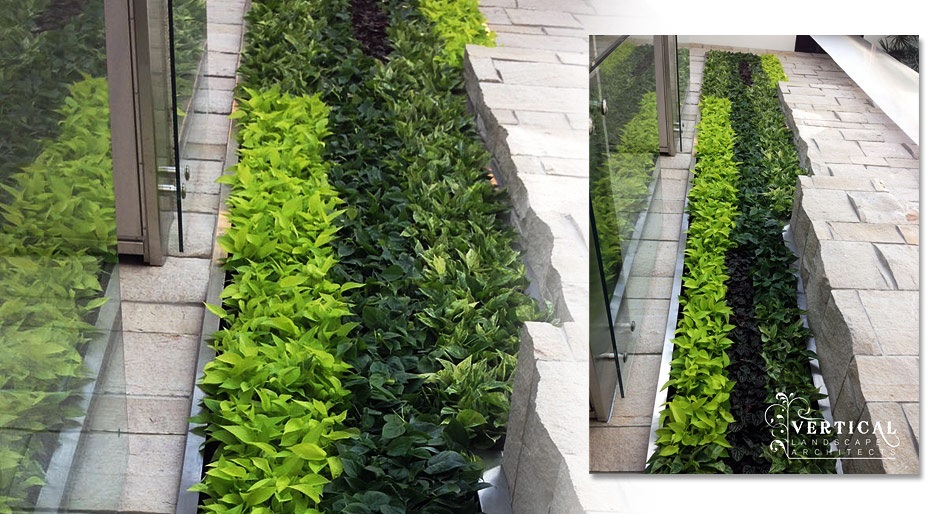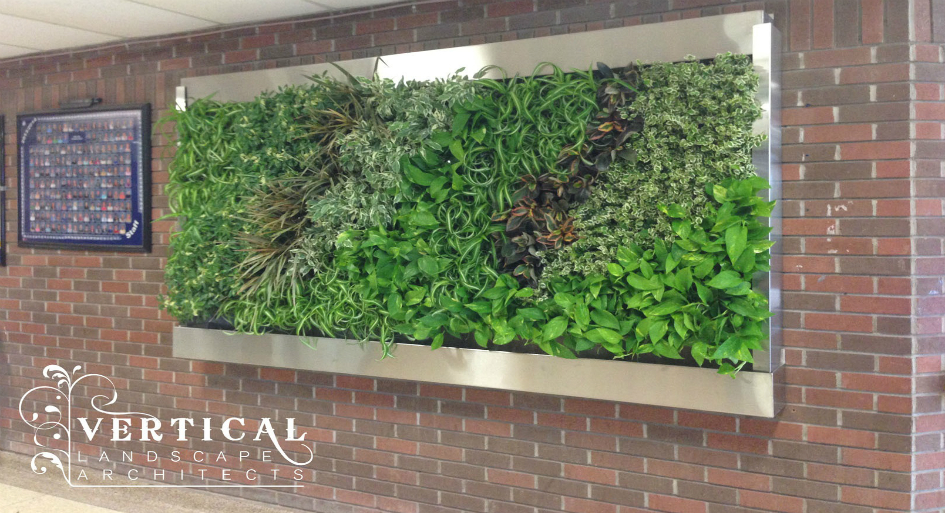Living walls are becoming increasingly popular in retail, institutional, office and residential interior spaces, and for good reason. Living walls expose employees, tenants, patients and residents to nature on a daily basis, and this can result in accelerated healing rates (in hospitals), greater tenant retention rates and lower employee absenteeism. The best part about living walls is that they provide all these benefits and take up little or no floor space.
Recently, Green Roofs for Healthy Cities (GRHC), North America’s green roof and wall industry association, released the results of the first-ever annual Green Wall Market Survey. After collecting limited data from green wall installers, manufacturers and designers, findings show that in 2015 more than 600,000 square feet of green walls were installed across North America. While more conclusive data is needed to support development, the green wall industry continues to be a growing market and offer facilities added value for a number of reasons.
GRHC notes that air that has been circulated throughout a building with a tactically placed green wall, such as near an air intake valve, will be cleaner than that on an uncovered building. The presence of vegetation indoors will have the same effect.
Through this process, oxygen is produced, while removing harmful toxins such as benzene, formaldehyde and trichloroethylene. Numerous studies have shown that plants in living walls can help neutralize the effects of sick building syndrome and provide significant physical and mental health benefits, including reduced stress levels.
Plants remove toxins from indoor air during photosynthesis and by microorganisms found in potting soil that colonize around plant roots. In fact, NASA researchers discovered that one plant can efficiently clean 100 square feet of home or office space. Most plant species that are effective at removing toxins can be employed in living walls. If improved air quality is a desired performance goal for your facility, select a living wall system that provides a high plant coverage per square foot and fill it with toxin removing plants.
In addition, a variety of different plant sizes and shapes create an irregular surface, which can be very effective at reducing noise, like a sound baffle. Living walls that are constructed with growing media can even mitigate harmful high and low frequency sounds in certain situations.
Living walls can also help earn LEED certification points if they are designed to utilize storm water collected on site, reduce wastewater, and are integrated with HVAC systems to improve air quality, or reduce energy consumption of a facility.
As for location, living walls should be placed in a prominent area as a focal point where there is high pedestrian traffic, such as a lobby, a reception area or a cafeteria, for example. People tend to want to spend time around living walls so it is a good idea to locate them in areas where seating already exists or can be added. By doing so, you will make the biggest impact and get the most out of your facility investment.
There is a variety of living wall systems on the market today but not all systems are created equal, and as the old saying goes, you get what you pay for. It is strongly advisable to pick a proven system that has worked well in similar conditions, without problems. The cost of a living wall will depend on its size, accessibility, material finishes, plant selection and mechanical requirements. It is more affordable to install and maintain a living wall in an area that is easily accessible and doesn’t require specialized equipment.
Maintenance is a key component of any successful living wall and should be performed at least once a month. Pruning, removal of dead plant material, preventative pest management, inspection and calibration of irrigation systems, fertilizer and nutrient top ups, as well as occasional system repairs and plant replacement are all part of a typical maintenance visit. As long as regular maintenance is performed, the likelihood of insect issues can be controlled with non-toxic products.
Living walls are specialized plant systems that require trained maintenance technicians, familiar with horticultural issues and specific living wall systems. If your living wall is tall and requires specialized equipment to access, your maintenance provider should also have training to work at heights and to operate such equipment.
Tropical plants are normally used in living walls and there is a range of plant species that can be implemented, depending on aesthetic preferences, maintenance considerations and light levels. It is important to note that all plants need a minimum amount of light and plant replacement can be significantly mitigated with optimal light levels and careful temperature control. If a living wall can’t be located in an area with direct natural light, supplemental light should definitely be added. The type of lights required will depend on many factors, including budget, energy consumption goals and the distance from the lights to the living wall. Living walls should never be located near exterior doors that will expose temperature-sensitive tropical plants to cold air during winter months.
Jason Rokosh, BD, MLA, OALA, CSLA, GRP, is the founder and owner of Vertical Landscape Architects Inc., and a specialist in living walls, green roofs and landscape architecture. Vertical Landscape Architects offers services in living wall and green roof consulting, design/build and maintenance mostly in the GTA and throughout southern Ontario. For more information please visit www.vertla.com.









